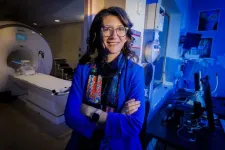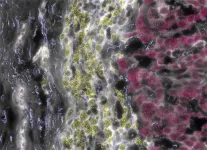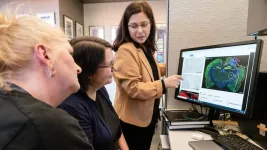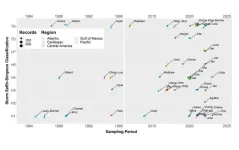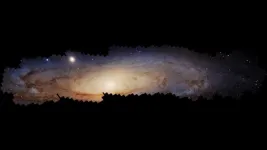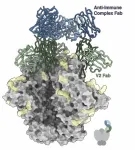(Press-News.org) Images
EAST LANSING, Mich. – Our sun is essentially a searing hot sphere of gas. Its mix of primarily hydrogen and helium can reach temperatures between 10,000 and 3.6 million degrees Fahrenheit on its surface and its atmosphere’s outermost layer. Because of that heat, the blazing orb constantly oozes a stream of plasma, made up of charged subatomic particles — mainly protons and electrons. The sun’s gravity can’t contain them because they hold so much energy as heat, so they drift away into space as solar wind. Understanding how charged particles as solar wind interact with other transient eruptions of energy from the sun can help scientists study cosmic rays emitted in supernova explosions.
Thomas Do, an astronomy graduate student at Michigan State University, published a paper predicting how particles accelerate under a wider net of circumstances than previous models. His model could be applied to solar storms that impact technology in space.
Do started working on charged particles three years ago during an undergraduate research project at the Harvard-Smithsonian Center for Astrophysics in Massachusetts. His research aimed to illuminate how charged particles accelerate when they’re swept along by powerful ejections of mass from the sun. Those explosions are called coronal mass ejections, and when they’re fast enough, they can create shock waves.
“As they fly out from the sun, they interact with charged particles along the way. During those interactions, particles gain energy from the shock wave,” Do said.
As the particles gain energy, they hurtle faster and faster into space and toward Earth. Sometimes, particles gain so much speed that they catapult past the crest of the shock wave, escaping from behind it and into the cosmos.
To understand how charged particles escape, Do expanded on a model developed in 2021 by Federico Fraschetti, an astrophysicist at the Center for Astrophysics. Fraschetti and Do’s updated model predicts how particles accelerate and escape under a wider range of energies than previous models. In particular, their model accounts for the escape from the accelerating region of particles over a range of higher and lower energies. That’s important, Fraschetti said, because previously only high-energy particles were thought to break free from riding a shock wave.
The previous model scientists used to make predictions about charged particles — developed around 50 years ago — didn’t include low-energy particles. Using multiple energy levels in their updated model, the team created a set of equations that predict how particles accelerate over time and how many particles escape at each energy level.
“We’re trying to allow for more particles to escape because we believe that’s more physically realistic,” Do said.
After expanding the model, he and Fraschetti wanted to compare it to an actual solar event.
They knew it was only a matter of time before they would have a chance, Fraschetti said. That’s because the sun reaches its solar maximum when solar activity is at its highest in its 11-year cycle. During a solar maximum, the massive explosions needed to generate shock waves are more frequent and more intense.
The team didn’t have to wait long for such an event. On Sept. 5, 2022, the sun spat a huge wad of energy into space just as NASA’s Parker Solar Probe took one of its closest dives toward the star. The probe recorded data such as particle speed and temperature as the explosion’s shock wave smashed into it.
“We were so lucky in September 2022 to see the very beginning of this process,” Fraschetti said. “This is one of the events that Parker Solar Probe was designed to measure.”
They found that their model’s prediction matched what the Parker Solar Probe reported: particle acceleration and escape across a range of energy levels. The probe was very close to the sun — for scale, if the Earth and sun were a meter apart, the probe would only have been about 7 centimeters away. That proximity meant that the particles it passed had recently crossed paths with the shock wave, so the team could see data on particles that hadn’t gained much speed yet.
“The model showed an excellent agreement with the data and confirmed that our physical expectation of what happens to young shock waves close to the sun is correct,” Fraschetti said. “We had never tested this expectation, and it did not have to be this way.”
"This model can be used in other areas of space research that involve charged particles," Do said.
###
Michigan State University has been advancing the common good with uncommon will for 170 years. One of the world’s leading public research universities, MSU pushes the boundaries of discovery to make a better, safer, healthier world for all while providing life-changing opportunities to a diverse and inclusive academic community through more than 400 programs of study in 17 degree-granting colleges.
For MSU news on the web, go to MSUToday or x.com/MSUnews.
END
MSU researcher’s breakthrough model sheds light on solar storms and space weather
2025-01-17
ELSE PRESS RELEASES FROM THIS DATE:
Nebraska psychology professor recognized with Presidential Early Career Award
2025-01-17
Maital Neta, professor of psychology at the University of Nebraska–Lincoln, has received the Presidential Early Career Award for Scientists and Engineers, the highest honor bestowed by the U.S. government on outstanding scientists and engineers early in their careers.
Neta, Carl A. Happold Professor of Psychology, directs the Cognitive and Affective Neuroscience Lab and is resident faculty of the Center for Brain, Biology and Behavior.
Neta said she was “very grateful” for the honor, announced ...
New data shows how ‘rage giving’ boosted immigrant-serving nonprofits during the first Trump Administration
2025-01-17
As Donald Trump prepares to take office for a second term as President, research led by the University of California, Santa Cruz is demonstrating the important role nonprofits played during Trump’s first term as a counterforce that channeled public resistance to anti-immigrant policies.
The new study, published in the journal International Migration Review, shows how nonprofits that provide legal services for immigrants ended up receiving increases in public contributions in the wake of Trump's attacks on immigrants.
Previously, there had been many reported examples of this backlash effect, sometimes called ...
Unique characteristics of a rare liver cancer identified as clinical trial of new treatment begins
2025-01-17
Like many rare diseases, fibrolamellar hepatocellular carcinoma (FLC) mounts a ferocious attack against an unlucky few—in this case, children, adolescents, and young adults. Because its symptoms can vary from person to person, it’s often missed or misdiagnosed until it has metastasized and becomes lethal. Moreover, drug therapies for common liver cancers are not just useless for FLC patients but actually harmful.
But new insights about the disease, coupled with a just-launched clinical trial of a promising drug treatment, could significantly improve health outcomes. Researchers in Rockefeller University’s Laboratory of Cellular Biophysics, headed by Sanford ...
From lab to field: CABBI pipeline delivers oil-rich sorghum
2025-01-17
Researchers at the Center for Advanced Bioenergy and Bioproducts Innovation (CABBI) have developed a new sorghum variant that can outperform soybeans in oil production, with great potential as a clean source of renewable fuel.
Scientists have long worked to create new sustainable sources of vegetable oils, known as triacylglycerols (TAG), to meet the growing demand for renewable fuels like sustainable aviation fuel (SAF) and renewable diesel.
Currently, oil palm and oilseeds such as soybeans provide most TAG for renewable ...
Stem cell therapy jumpstarts brain recovery after stroke
2025-01-17
SAN FRANCISCO—Every 40 seconds, someone in the United States has a stroke. For survivors of the most common type of stroke, called an ischemic stroke, only about 5 percent fully recover. Most others suffer from long-term problems, including weakness, chronic pain, or epilepsy.
Now, scientists at Gladstone Institutes and the regenerative medicine company SanBio have shown that a cell therapy derived from stem cells can restore normal patterns of brain activity after a stroke. While most stroke treatments must be administered in the immediate hours ...
Polymer editing can upcycle waste into higher-performance plastics
2025-01-17
Polymer editing can upcycle waste into higher-performance plastics
By editing the polymers of discarded plastics, chemists at the Department of Energy’s Oak Ridge National Laboratory have found a way to generate new macromolecules with more valuable properties than those of the starting material. Upcycling may help remedy the roughly 450 million tons of plastic discarded worldwide annually, of which only 9% gets recycled; the rest is incinerated or winds up in landfills, oceans or elsewhere.
ORNL’s ...
Research on past hurricanes aims to reduce future risk
2025-01-17
Tropical storms like hurricanes are not only terrifying, but also incredibly costly for coastal regions across the United States, Mexico, Central America and the Caribbean. Beyond the immediate devastation, these storms contribute to significant economic losses and human displacement. In 2023 alone, climate migration linked to such events saw 2.5 million individuals attempt to cross the U.S. southern land border.
New research led by The University of Texas at Arlington emphasizes that studying ...
UT Health San Antonio, UTSA researchers receive prestigious 2025 Hill Prizes for medicine and technology
2025-01-17
SAN ANTONIO, Jan. 17, 2025 – On the eve of a historic merger between The University of Texas Health Science Center at San Antonio and The University of Texas at San Antonio, researchers from the two institutions have been honored with highly prestigious 2025 Hill Prizes, in medicine and technology.
The prizes are awarded by the Texas Academy of Medicine, Engineering, Science and Technology (TAMEST), and Lyda Hill Philanthropies, which fund the awards to “propel high-risk, high-reward ideas and innovations that demonstrate very significant potential for real-world impact and can lead ...
Panorama of our nearest galactic neighbor unveils hundreds of millions of stars
2025-01-17
In the decades following the launch of NASA's Hubble Space Telescope, astronomers have tallied over 1 trillion galaxies in the universe. But only one galaxy stands out as the most important nearby stellar island to our Milky Way — the Andromeda Galaxy. It can be seen with the naked eye on clear autumn nights as a faint oval object roughly the size of the moon.
A century ago, astronomer Edwin Hubble first established that this so-called "spiral nebula" was approximately 2.5 million light years away from our own Milky Way galaxy.
Now, the space telescope named ...
A chain reaction: HIV vaccines can lead to antibodies against antibodies
2025-01-17
LA JOLLA, CA—Many vaccines work by introducing a protein to the body that resembles part of a virus. Ideally, the immune system will produce long-lasting antibodies recognizing that specific virus, thereby providing protection.
But Scripps Research scientists have now discovered that for some HIV vaccines, something else happens: after a few immunizations the immune system begins to produce antibodies against immune complexes already bound to the viral protein alone. They don’t yet know whether this chain reaction, described in Science ...
